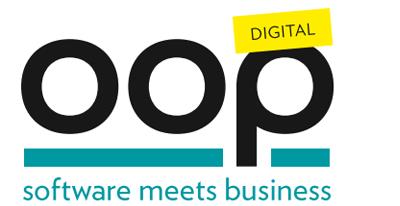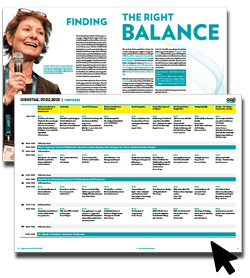Das gesamte Konferenzprogramm auf einem Blick? Kein Problem, alle Programminhalte finden Sie hier jetzt auch als praktische PDF-Broschüre ganz bequem zum durchscrollen, downloaden oder ausdrucken:
Zur PDF-Broschüre
Thema: Cloud
- Dienstag
07.02. - Mittwoch
08.02. - Donnerstag
09.02.
Über Daten-Streaming und Apache Kafka redet die Welt. Kai Waehner, Field CTO bei Confluent, stellt uns in dieser Keynote die Prognosen für die fünf wichtigsten Use Cases und Architekturen in diesem Bereich für 2023 vor und welche Trends er bei Kunden industrieübergreifend feststellen konnte: Dezentraler Data Mesh: Fokussierung auf den Geschäftswert durch den Aufbau von Datenprodukten in unabhängigen Domänen mit verschiedenen Technologien. Cloud-natives Lakehouse: Anwendung einer…
Die Digitalisierung schreitet voran! Geht es den einen zu langsam, gibt es andere, denen es zu schnell geht.
Beiden Parteien gemeinsam ist, dass es das richtige Mindset braucht, um den Herausforderungen der Digitalisierung und der damit einhergehenden Transformation Tempo zu verleihen oder mit ihr Schritt halten zu können.
In dem Vortrag schauen wir uns die unterschiedlichen Dimensionen an, für die ein Umdenken angesagt ist. Dabei spannen wir den Bogen von der Fachlichkeit über die Technologie…
Re-purchasing an application is seen as the top of craftsmanship for cloud migrations. But people have rarely seen such a project in practice. This is the courageous journey of a real consumer product running on expensive infrastructure for years with 2 million active users and more than 6PB of data.
The talk takes you on a journey to a German public cloud and shares all the learnings - about shifting massive data, about terraforming infrastructures, about customizing open source and about all…
I will share our hands-on experience with a cloud native (container) transformation that is currently unfolding. Technically, implementing an Open Shift Container Platform (bare metal) is pretty challenging. Doing this in a way that we will have pretty stuff in our data centers and at the same time making sure that our technical possibilities are actually being used effectively by product developers ... is a different challenge all together.
Join this session if you'd like to hear what we…
Integration war und ist immer noch relevant - vielleicht mehr denn je. Insbesondere, wenn wir über Anwendungsmodernisierung sprechen. In Zeiten von Cloud- und Microservice-Architekturen müssen wir neu darüber nachdenken, wie wir Integrationsherausforderungen bewältigen können. Klassische ESB-Lösungen sind meist veraltet - was aber ist die Alternative?
Anhand der Erfahrungswerte aus unserem eigenen IT-Modernisierungsprojektes, werde ich vorstellen, wie Integrationsherausforderungen heute mit…
Die Welt der operativen, transaktionalen Systeme und der analytischen Systeme ist seit jeher getrennt. Unterschiedliche SW-Entwicklungsparadigmen, andere Technologien, andere Datenmodelle, usw. prägen die jeweiligen Systeme. Statt Silos zu bauen, geht es darum, eine Balance zu finden zwischen Dev und Data: DevDataOps? Wie können Data Mesh und Data Lakehouse dazu beitragen?
Zielpublikum: Architekt:innen, Entwickler:innen, Projektleiter:innen, Manager, Entscheider
Voraussetzungen: Keine
Schwierigk…
Firmen können kaum noch IT-Systeme neu entwickeln, ohne dass existierende Funktionalität mitwandert. Vor die Aufgabe gestellt, ein System von einem Fremdanbieter in eine Public Cloud zu überführen, hat sich gezeigt, dass hilfreiche Wanderführer rar sind.
Diese Session strukturiert Entscheidungswege und Erkenntnisse bei Cloud-basierten Migrationsvorhaben - abgeleitet aus der Migration und Modernisierung von einem Konsumenten-Service mit 6 PB Daten und ca. 2 Mio. Nutzern.
Zielpublikum:…
Modernization projects are not a straight line as there’s no one-stop shop. Balance is definitely the right word: we talk here about finding the proper trade-off between quality/costs/timeframe requirements and customized patterns for a successful legacy system modernization. Based on actual use cases, we’ll discuss the available solutions (ERP implementation, code rewriting, middleware, cloud…), and see why combining the relevant tools is key.
Let us take you on a modernization journey and get…
The cloud has fundamentally changed how we design applications and introduced whole new categories of software-development disasters. With a focus on Java, this talk will introduce some of the new tools, patterns, and best practices for modern distributed application development. It also gives a tour of some of the most painful anti-patterns Holly has seen as a cloud consultant.
Target Audience: Architects, Developers, Strategic Decision Makers
Prerequisites: Basic experience of cloud computing,…
Learn key patterns, practices, tools, and techniques which lead to successful cloud adoption. Lynn's work with research teams around genomic-scale data pipelines for human health will be highlighted in this keynote.
Auch nach mehr als 20 Jahren ist Jakarta EE (ehemals Java EE) DER Standard, wenn es um die Entwicklung Java-basierte Enterprise Computing-Lösungen geht. Dies gilt zumindest immer dann, wenn die Anwendung als Monolith in einem Application Server deployed werden soll. Wie aber steht es mit einer Anwendung, die aus einer Vielzahl autark laufender Microservices besteht? Und wie gut schlägt sich Jakarta EE in der Cloud, in der geringer Speicherbedarf und schnelle Startzeiten gefragt sind?
Zielpubliku…
Webanwendungen ohne automatisiert getestete APIs machen im Betrieb und Weiterentwicklung schlechte Laune, egal, ob es um APIs zwischen Frontend und Backend, zwischen Microservices oder zu Drittparteien geht. Typischerweise beschreiben wir das erwünschte Verhalten der Anwendung, in dem wir uns selbst Beispiele als Testfälle ausdenken. Da geht mehr. In diesem Beitrag werfen wir einen Blick auf über "naive Integrationstests" hinausgehende Ansätze, von Contract Based bis hin zu KI-Unterstützung.
Zie…
Java applications are widely used and often several years old. You can use these applications in the cloud via lift-and-shift (helps nothing) or you can rewrite the application in cloud-native style and use the advantages of the cloud.
An alternative for existing applications is missing here. It must be possible to go to the cloud and use advantages such as serverless and scale-to-zero WITHOUT having to rewrite the entire application.
I will show what is already working well today and where the…
Since the dawn of software development, programmers have been perpetually occupied with migrating our "legacy" code to "the new platform". As soon as we finish, it is obsolete, and we need to start over. Today we are typically in the midst of moving to the cloud. We need DevOps, microservices, new frontend frameworks ... there is always some new tool that promises to deliver much better value than our existing solutions. Millions - even billions - are spent on these initiatives. Are they worth…


